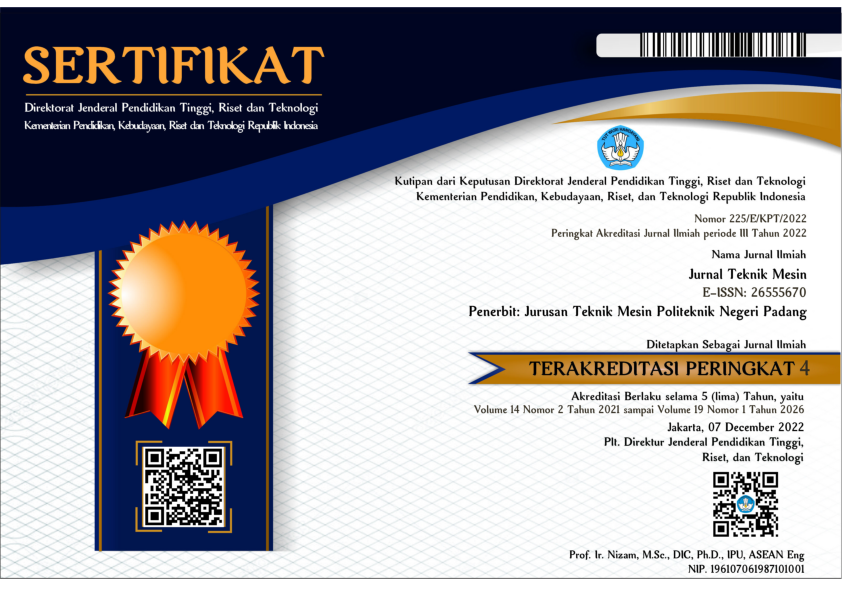Pengaruh Overlap Ratio pada Model Turbin Savonius terhadap Karakteristik Koefisien Daya Berdasarkan Eksperimen Pada Wind Tunnel
Abstract
Wind energy is a resource that is abundant, environmentally friendly, and renewable, therefore it has the potential to be developed. Savonius vertical axis type is suitable for application in low wind speed conditions. The Savonius wind turbine has good self-starting so that it is able to rotate the rotor even though the wind speed is low, besides that the torque it produces is relatively high. This study aims to determine how differences in OR affect the performance of Savonius turbines with an aspect ratio (AR) of 2. The experimental method was applied in this research to investigate the characteristic Cp of the model using the wind tunnel with different overlap ratios of 0.1, 0.15, 0.2, 0.25, and 0.3. The wind turbine model that has been made using a 3D printing process made of PLA + material. The results obtained in each OR test are the maximum Cp value for the variation OR 0.1, which is 0.121, OR 0.15, the maximum Cp value obtained is 0.213, OR 0.2, the maximum Cp value is 0.245, OR 0.25, the maximum Cp value is 0.224 and OR 0.3, the maximum Cp value is 0.210. Based on the five overlap variations, the maximum Cp ratio is obtained at OR = 0.2, namely Cp = 0.245 and TSR = 0.7. The OR value of 0.2 is able to maximize turbine power and minimize negative torque because the flow through the overlap area can maximally direct wind power to the maximum backward blade.
References
[X. Yang, J. Pang, F. Teng, R. Gong, and C. Springer, The environmental co-benefit and economic impact of Chinas low-carbon pathways: Evidence from linking bottom-up and top-down models, Renewable and Sustainable Energy Reviews, vol. 136, (2021), Http://doi.org/10.1016/j.rser.2020.110438
Martin O. L. Hansen, (2007), Aerodynamics of Wind Turbines Second Edition, London Sterling, VA, https://doi.org/10.4324/9781849770408
Mr. P. R. M. Shailendra Sao, Analysis of NACA 4415 Blade profile For Horizontal Axis Wind Turbine Using Various Aerodynamic Characteristics, (2017).
I. Sofiati, E. Yulihastin, and M. F. Putranto, Meridional variations of sea surface temperature and wind over southern sea of Java and its surroundings. Journal of Physics and Its Applications Vol:3 No.1, (2020),
https://doi.org/10.14710/jpa.v3i1.9374 [9] N. A. Satwika, R
Hantoro, E. Septyaningrum, and A. W. Mahmashani, Analysis of wind energy potential and wind energy development to evaluate performance of wind turbine installation in Bali, Indonesia, Journal of Mechanical Engineering and Sciences, vol. 13, no. 1, (2019): 44614476, Http://doi.org/10.15282/jmes.13.1.2019.09.0379
K. A. H. Al-Gburi, F. B. I. Alnaimi, B. A. Al-quraishi, E. Sann Tan, and M. M. Maseer, A comparative study review: The performance of Savonius-type rotors, Material Today Proc, (2022): 343349, Http://doi.org/10.1016/j.matpr.2021.09.226
S. H. Chaklasiya, R. R. Saxena, and P. v Ramana, Review on Performance Evaluation of Helical Savonius Wind Turbine, vol. 4, no. 1, (2018): 14641471
[T. Zhipeng, Y. Yingxue, Z. Liang, and Y. Bowen, A review on the new structure of savonius wind turbines, in Advanced Materials Research, vol. 608609, (2013): 467478. Http://doi.org/10.4028/www.scientific.net/AMR.608-609.467
K. H. Wong, W. T. Chong, N. L. Sukiman, S. C. Poh, Y. C. Shiah, and C. T. Wang, Performance enhancements on vertical axis wind turbines using flow augmentation systems: A review, Renewable and Sustainable Energy Reviews, vol. 73, no. June 2016, (2017):904921, Http://doi.org/10.1016/j.rser.2017.01.160
M. Zemamou, M. Aggour, and A. Toumi, Review of savonius wind turbine design and performance, Energy Procedia, vol. 141, no. December, (2017): 383388, Http://doi.org/10.1016/j.egypro.2017.11.047
Z. Tasneem et al., An analytical review on the evaluation of wind resource and wind turbine for urban application: Prospect and challenges, Developments in the Built Environment, vol. 4. Elsevier Ltd, (2020). Http://doi.org/10.1016/j.dibe.2020.100033
N. Fujisawa, On the torque mechanism of Savonius rotors, Journal of Wind Engineering and Industrial Aerodynamics Volume 40, Issue 3, (1992) :277-2921 https://doi.org/10.1016/0167-6105(92)90380-S
B. F.Blackwell, R. E. Sheldahl, and L. v Feltz, Wind Tunnel Performance Data for TWO-and Three Bucket Savonius Rotors. ARC, Vol.2 No.3, (2012), https://doi.org/10.2514/3.47966
A. J. Alexander and B. P. Holownia, Wind Tunnel Tests On A Savonius Rotor, (1978).
https://doi.org/10.1016/0167-6105(78)90037-5
Mojola, On the aerodynamic design of the savonius windmill rotor, Journal of Wind Engineering and Industrial Aerodynamics, vol. 21, (1985): 223231. https://doi.org/10.1016/0167-6105(85)90005-4
S. F. Dorel, G. A. Mihai, and D. Nicusor, Review of specific performance parameters of vertical wind turbine rotors based on the Savonius type, Energies, vol. 14, no. 7. MDPI AG, (2021), Http://doi.org/10.3390/en14071962













